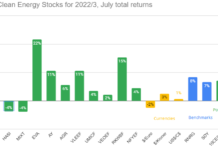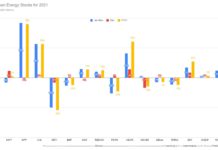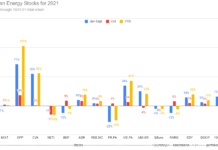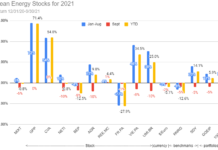And Two Speculative Clean Energy Penny Stocks for 2014
Tom Konrad CFA
My annual model clean energy portfolio.
I’ve been creating model portfolios of clean energy stocks since 2008. At first, it was just a list, but in 2009 I started tracking it as a model portfolio for a small stockmarket investor. With the exception of last year, clean energy stocks have had fairly miserable returns, as measured by my sector benchmark, specified at the start of each year. I’ve been using the Powershares Wilderhill Clean Energy ETF (PBW) for all but the first couple years. I plan to continue using PBW going forward, since it is the most widely held sector ETF, and so is a good measure of how the average clean energy investor might do over the course of the year.
As you can see from the chart below, 2013 was the first year that my model portfolio did not beat its benchmark… and also the first year that benchmark returned more than 12%. The last year PBW returned 60% was 2007, the year before I started publishing these portfolios.

The chart also shows trailing three and five year annualized returns. All of the three year returns are negative for both the benchmark and a little less so for my model portfolios. Among the five year returns, only that of the model portfolios from 2009 to 2013 is even slightly positive at an average annual return of 3% per year.
2013 in Review

Despite a 25% return in 2013, I was disappointed my model portfolio has not matched the benchmark’s stellar returns. While the portfolio included two stocks which more than doubled, the portfolio’s returns were significantly reduced by the inclusion of Lime Energy (NASD:LIME) and Finavera Wind Energy (TSX-V:FVR, OTC:FNVRF). These two, along with the worst-performing alternate pick, Ram Power (TSX:RPG, OTC:RAMPF) all suffered from specific business setbacks which had large negative impacts on their stock because of their small size and lack of internal sources of funds. As I wrote earlier this month, I plan to avoid such companies in this list going forward.
The portfolio was also held back by accounting problems at Maxwell Technologies (NASD:MXWL.) While I warned readers to sell Maxwell on my Forbes blog at only a 2% loss at the start of March, I manage the model portfolio as a buy-and hold investor would, and only switched Maxwell out at the start of April, when it was down 39%, replacing it with Ameresco (NASD:AMRC.) Both stocks subsequently recovered, but the delayed swap was a drag on portfolio performance. Had I swapped the two stocks on March 13th, the day after publishing my article on Maxwell, the Maxwell/Ameresco combination would have gained 17% rather than falling 19%, and the portfolio as a whole would have risen 29% rather than 25%.
Ten Clean Energy Stocks for 2014
My list for 2014 contains a large number of hold-overs from the 2013 list which did not participate in the general rise of clean energy stocks despite strong business prospect. This year, I will present my picks in rough order of risk, from the rather safe income stocks to a couple deep value stocks. I will also include two price targets, a low target for reflecting what I would expect to happen in a worst-case scenario, and a high target, if everything goes as planned. I expect well over half of these stocks will fall between the low and the high targets at the end of 2014.
1. Hannon Armstrong Sustainable Infrastructure (NYSE:HASI).
Current Price: $13.85. Annual Yield: 6.4%. Low Target: $13. High Target: $16.
I’ve written extensively about sustainable infrastructure REIT Hannon Armstrong since its IPO in the spring of 2013. Despite its recent run-up on the news of its $0.22 quarterly dividend, I expect the current yield and expected further dividend increases in 2014 will keep the stock from falling, and will likely drive more appreciation.
2. PFB Corporation (TSX:PFB, OTC:PFBOF).
Current Price: C$4.85. Annual Yield: 4.9%. Low Target: C$4. High Target: C$6.
Green Builder PFB returns to the list after 2013, when it paid C$1.24 in dividends, but gave back almost as much in share price. This stock is fairly illiquid, so it’s best to only buy or sell using limit orders. In addition to its dividend payout, the company has been actively repurchasing stock since the start of December.
3. Capstone Infrastructure Corp (TSX:CSE. OTC:MCQPF).
Current Price: C$3.55. Annual Yield: 8.5%. Low Target: C$3. High Target: C$5.
Capstone is a Canadian power producer which is currently selling at a discount because of extended negotiations with the Ontario Power Authority over the renewable of the electricity purchase contract for its largest facility, a gas co-generation plant in cardinal, Ontario. The new contract is unlikely to be favorable to Capstone, but the stock market already seems to be pricing in a significant dividend cut, so even a “not horrible” contract could cause the stock to rebound. If not, the current C$0.075 quarterly dividend should offset most of the losses in even the most pessimistic case.
4. Primary Energy Recycling Corp (TSX:PRI, OTC:PENGF).
Current Price: C$4.93. Annual Yield: 4.1%. Low Target: C$4. High Target: C$7.
Primary Energy owns five cogeneration projects recycling waste heat from steel facilities on Lake Michigan in Northern Indiana. They are currently finalizing a new contract at one of their plants. When that contract is finalized, they will have the ability to raise debt financing backed by the facility which could then be invested in expanding the business. One other potential upside is the possible sale of the company. According to a research note from John McIlveen at Jacob Securities, “A group of five investors collectively holding 55% of PRI have taken board seats including chairman which leads us to believe the company may be in play once the events become reality.”
5. Accell Group (Amsterdam:ACCEL, OTC:ACGPF).
Current Price: €13.59. Annual Yield: 5.5%. Low Target: €11.5. High Target: €18.
International bicycle manufacturer returns for another year after a modest 11% total return in 2013. Despite its growing e-bike business, Accell has been held back by a slow market in Europe
, but cost savings from the integration of Raleigh and recent restructuring this year should pay off in 2014.
6. New Flyer Industries (TSX:NFI, OTC:NFYEF).
Current Price: C$10.57. Annual Yield: 5.1%. Low Target: C$8. High Target: C$16.
Leading North American bus manufacturer New Flyer was relegated to an alternative pick last year because I felt it was not as attractively valued as the stocks which made my top ten. Had I known about their soon-to-be-announced partnership and investment from Brazilian bus manufacturer Marco Polo SA and their subsequent acquisition of the parts businesses of two other bus manufacturers, I would have put it in the list, and then been surprised by the solid-but-unexciting 18% total return. Perhaps investors will recognize New Flyer’s increased dominance of the recovering North American bus industry this year.
7. Ameresco, Inc. (NASD:AMRC).
Current Price: $9.64. Annual Yield: N/A. Low Target: $8. High Target: $16.
Energy service contractor Ameresco is also back on the list after a year in the alternative pick wilderness in 2013. The delays in finalizing contracts which have brought the stock down for the last two years continue, but such delays cannot continue indefinitely. Many of Ameresco’s customers come to it because they need to replace equipment at its end of life. Ameresco offers such clients new, energy-efficient equipment at no up-front cost, paid for out of energy savings. No matter how uncertain budgeting is among the government and institutional entities Ameresco serves, there is a limit to how long the replacement of aging equipment can be delayed. Navigant predicts that the energy service business will grow 8% next year and reach $8.3 billion by the end of the decade from $4.9 billion this year. Insiders were buying the stock in November.
8. Power REIT (NYSE:PW).
Current Price: $8.42. Annual Yield: N/A. Low Target: $7. High Target: $20.
Rail and solar REIT cut its dividend to $0 in 2013 to fund its ongoing civil action in its attempt to foreclose on its lessee Norfolk Southern Corporation (NYSE:NSC) and sub-lessee Wheeling & Lake Erie Railway (WLE). While the lease provides that the lessees are responsible for Power REIT’s legal costs defending its interest in its property, the lessees have failed to pay those costs. Their recovery in addition to that of significant indebtedness on the part of NSC and WLE are a significant part the dispute, and will depend on the judge’s eventual ruling as well as any appeals and negotiations between the parties.
In the meantime, Power REIT has made progress diversifying itself into solar. The civil action continues to cast a shadow on the company’s ability to borrow from banks to finance its expansion into solar, so Power REIT is working on selling 7.75% preferred stock instead.
Resolution of the litigation contains significant potential upside in addition to removing significant ongoing expenses. In the case of a loss, the company should be able to write off approximately $17 million in indebtedness owed by the lessees for significant tax advantages. In the case of a win for Power REIT, the benefits could easily exceed the company’s entire market capitalization. Any settlement will likely fall somewhere in between.
9. MiX Telematics Limited (NASD:MIXT).
Current Price: $12.17. Annual Yield: N/A. Low Target: $8. High Target: $25.
I found out about global fleet management provider MiX Telematics from Rafael Coven when I asked him for his top picks for 2014. Coven is manager of the Cleantech index (^CTIUS) which underlies the Powershares Cleantech ETF (NYSE:PZD.) MiX provides vehicle and fleet management solutions delivered as software as a service to customers in 112 countries. The company’s customers benefit from increased safety, efficiency and security.
MiX falls firmly into the peak oil investing theme which I call Smart Transportation. It reduces oil use through improving driving and route efficiency at minimal up-front cost. Since it is often difficult to get customers interested in a product simply because of the cost savings from efficiency, the safety and security benefits are likely to drive the adoption of MiX’s solutions much more quickly than those of other energy efficiency companies which rely on cost savings as the sole incentive.
10. Alterra Power Corp. (TSX:AXY, OTC:MGMXF).
Current Price: C$0.28. Annual Yield: N/A. Low Target: C$0.20. High Target: C$0.60.
Unlike Ram and Finavera, Alterra Power is a renewable energy developer with a diversified portfolio of operating plants as well as development projects. When outside investment is difficult or expensive to come by, as it is today, the company has the option of pursuing joint ventures or selling stakes in some projects to fund development of others. It has been pursuing both these strategies recently, with the most recent deal being the partial sale of its interest in its Dokie wind farm for C$29 million. That interest amounts to only 3% to 5% of its power production, revenues, or EBITDA, depending on which metric is used, but the sale amounts to a cash infusion of 6 cents a share, or 20% of the current stock price.
As that transaction shows, Alterra is massively undervalued based solely on the potential sale price of its operating assets. With cash in hand and no need to return to capital markets to fund operations or development projects, this value is unlikely to be lost through dilution or operating expenses, as we saw with Ram Power and Lime Energy this year. Alterra’s CEO, John Carson, bought C$10,000 worth of stock on the public market for C$0.30 at the end of October.
Two Speculative Penny Stocks for 2014
Although I plan to drop Ram and Finavera from the list this year, I feel their current low prices make them interesting (if still risky) speculative stocks, and so I will continue to write about them along with the main list in my near-monthly updates. As of the close on December 27th, Ram Power was C$0.08, and Finavera was C$0.075. Either could go to zero over the course of 2014, or they could rise to over 20 cents if Ram succeeds in finding a buyer or Finavera finalizes the sale of its Canadian wind farms to Pattern Energy Group (NASD:PEGI.)
Conclusion
Given the current high valuations of the broad market as a whole and many clean energy stocks in particular, I seriously doubt 2014 will bring a repeat the stellar performance of clean energy stocks in 2013. I would be pleasantly surprised if my model portfolio were to return its more modest 25% this year. That said, the large proportion of income and value stocks in the portfolio should give downside protection in a bear market, while affording the opportunity of decent returns if the economy continues its current modest pace of
recovery.
If we have another blow-out year like 2013, expect this model portfolio to underperform again, but expect it to outperform if markets post modest returns or end the year down.
Disclosure: Long HASI, PFB, CSE, ACCEL, NFI, PRI, AMRC, MIXT, PW, AXY, RPG, FVR, LIME
DISCLAIMER: Past performance is not a guarantee or a reliable indicator of future results. This article contains the current opinions of the author and such opinions are subject to change without notice. This article has been distributed for informational purposes only. Forecasts, estimates, and certain information contained herein should not be considered as investment advice or a recommendation of any particular security, strategy or investment product. Information contained herein has been obtained from sources believed to be reliable, but not guaranteed.








3 Cheers for the annual list! The addition of rough target prices is very helpful and appreciated. My problem is that I only own 60% of your new 10.
Nice to see you endorsing PFB again. I did not understand the low price there this year and wondered what I’d been missing.
1. I own 100% of the new ten… I used the TSX tickers in the disclosure (I.e. CSE instead of MCQPF for Capstone.) Was that why you thought I only owned 6/10?
2. PFB is so illiquid that slight changes in supply and demand can make large changes to the price.It’s always been cheap because of the iliquidity, now it’s just cheaper.
No, its me that only owns 60%. Not saying you don’t own them all.